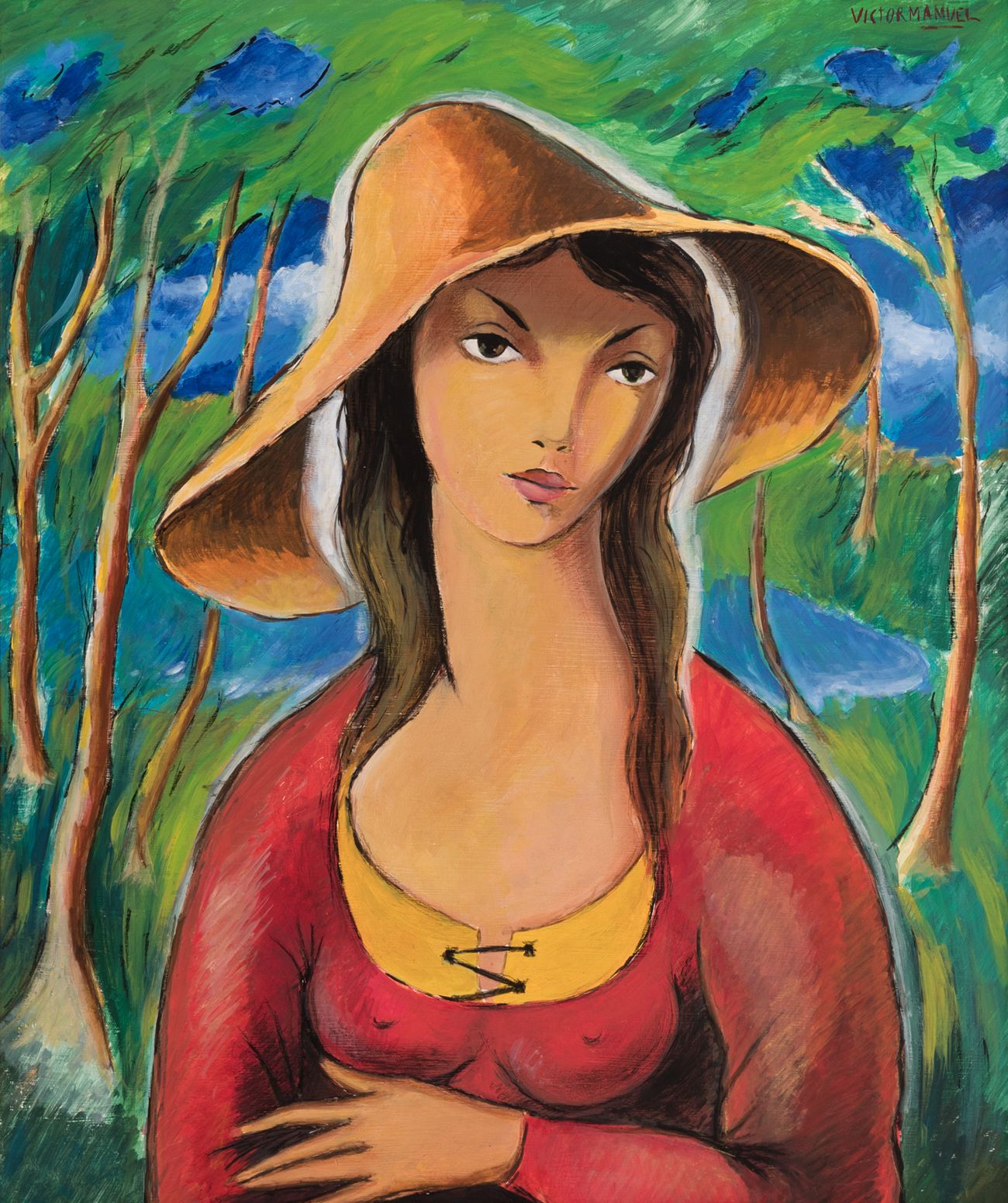Description
VÍCTOR MANUEL GARCÍA VALDÉS (Havana, 1897 - 1969). "Girl with a palette". Mixed media on masonite. Signed in the upper right corner. Provenance: La Acacia Gallery (Cuba). Measurements: 50,2 x 58,5 cm; 67 x 58 cm (frame). In this work we can observe a three-quarter portrait, where the author presents us a young girl whose features are softened by the use of the curved lines and the pastel colours used. The girl crosses her arms under her chest and looks directly at the viewer. Adopting a direct gesture with regard to her relationship with the viewer. The young girl is set in a landscape of bright tones, which envelop the young woman in an atmosphere with a certain naïve touch and sensual warmth. Qualified as the father of the Golden Age of Cuban painting, Víctor Manuel García trained at the San Alejandro Academy of Fine Arts in Havana. He held his first solo exhibition until 1924, and the following year he travelled to Paris. He returned to Cuba in 1927, and that same year he took part in the exhibition of the Association of Painters and Sculptors of Havana, considered one of the starting points of modern Cuban painting. He then embarked again for Europe, embarking on a journey that took him to Spain and Belgium, returning to Cuba in 1929. That same year he created his most famous work, "La gitana tropical", popularly known as the "American Gioconda", which is now kept in the National Museum of Fine Arts in Havana. In 1935 he was awarded first prize at the Havana Lyceum Exhibition, and continued to hold exhibitions of his work both in Cuba and abroad. Victor Manuel's style was not monolithic, but evolved greatly throughout his life. His early paintings show a tendency to mix European styles with an earthy primitivism, an example of which is his piece La Gitana Tropical (1929). In the 1940s and 1950s, however, he adopted a more stylised look that became a hallmark of his work. During the last years of his life, his style became almost abstract, with portraits suggesting a close proximity to the aesthetics of Cubism. He was very inconsistent in signing his work, ranging from a simple "VICTOR MANUEL" in capital letters to a fluid and complicated script, and even used a pseudonym at one period of his life. He was eminently a portraitist of female faces, as well as a painter of landscapes, both rural and urban.
67
VÍCTOR MANUEL GARCÍA VALDÉS (Havana, 1897 - 1969). "Girl with a palette". Mixed media on masonite. Signed in the upper right corner. Provenance: La Acacia Gallery (Cuba). Measurements: 50,2 x 58,5 cm; 67 x 58 cm (frame). In this work we can observe a three-quarter portrait, where the author presents us a young girl whose features are softened by the use of the curved lines and the pastel colours used. The girl crosses her arms under her chest and looks directly at the viewer. Adopting a direct gesture with regard to her relationship with the viewer. The young girl is set in a landscape of bright tones, which envelop the young woman in an atmosphere with a certain naïve touch and sensual warmth. Qualified as the father of the Golden Age of Cuban painting, Víctor Manuel García trained at the San Alejandro Academy of Fine Arts in Havana. He held his first solo exhibition until 1924, and the following year he travelled to Paris. He returned to Cuba in 1927, and that same year he took part in the exhibition of the Association of Painters and Sculptors of Havana, considered one of the starting points of modern Cuban painting. He then embarked again for Europe, embarking on a journey that took him to Spain and Belgium, returning to Cuba in 1929. That same year he created his most famous work, "La gitana tropical", popularly known as the "American Gioconda", which is now kept in the National Museum of Fine Arts in Havana. In 1935 he was awarded first prize at the Havana Lyceum Exhibition, and continued to hold exhibitions of his work both in Cuba and abroad. Victor Manuel's style was not monolithic, but evolved greatly throughout his life. His early paintings show a tendency to mix European styles with an earthy primitivism, an example of which is his piece La Gitana Tropical (1929). In the 1940s and 1950s, however, he adopted a more stylised look that became a hallmark of his work. During the last years of his life, his style became almost abstract, with portraits suggesting a close proximity to the aesthetics of Cubism. He was very inconsistent in signing his work, ranging from a simple "VICTOR MANUEL" in capital letters to a fluid and complicated script, and even used a pseudonym at one period of his life. He was eminently a portraitist of female faces, as well as a painter of landscapes, both rural and urban.
